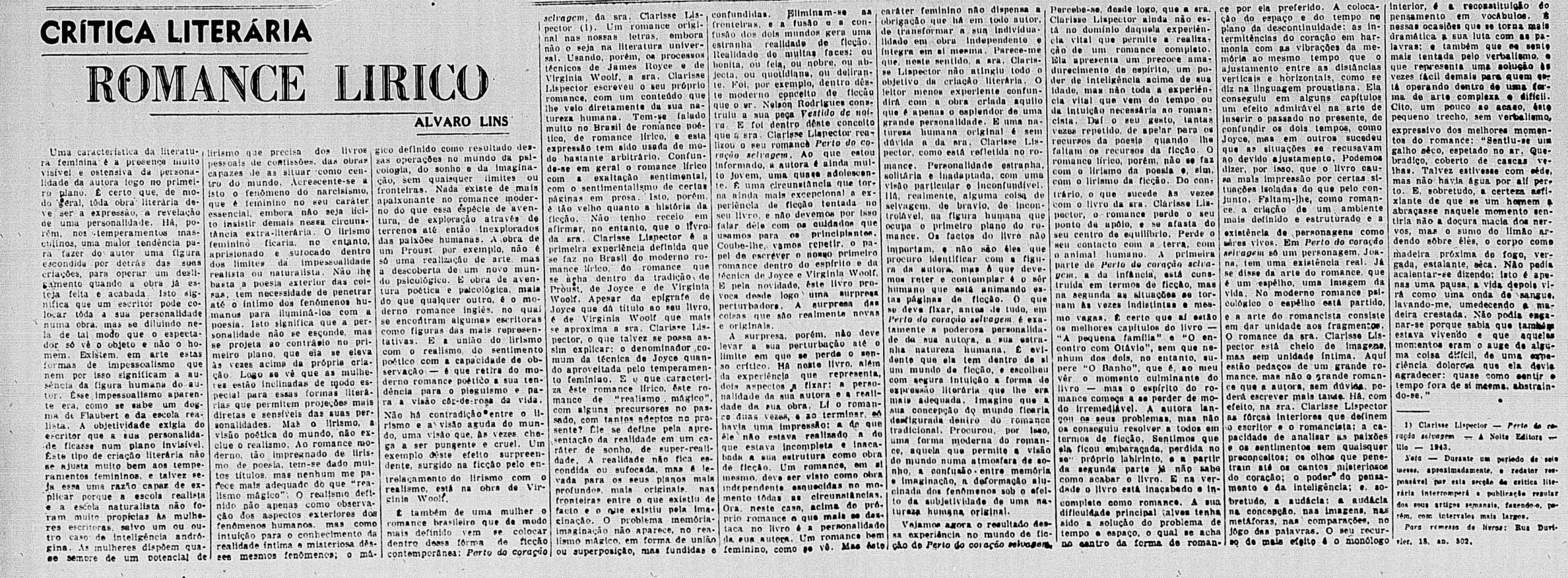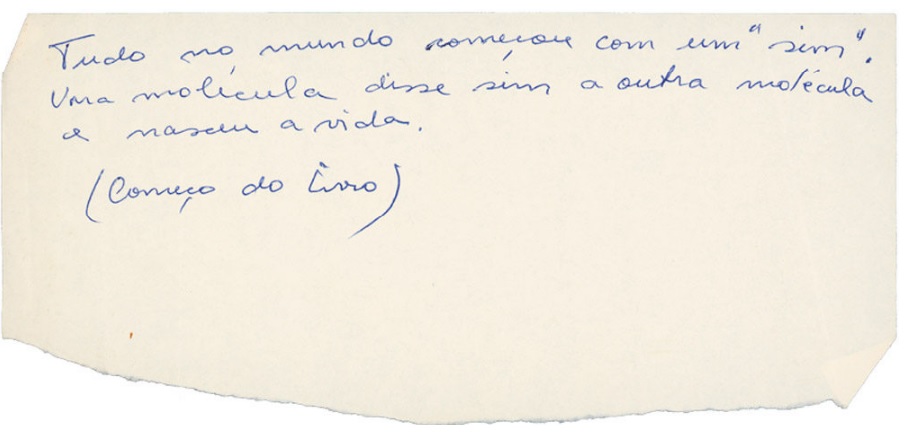, A Wild Review of Near to the Wild Heart. IMS Clarice Lispector, 2017. Disponível em: https://site.claricelispector.ims.com.br/en/2017/03/03/uma-critica-selvagem-para-perto-do-coracao/. Acesso em: 26 July 2024.
It is the end of 1943. A publishing house of little cultural relevance, A Noite, releases the exceptional original version of Near to the Wild Heart, a book by a 22-year-old author and former employee of the publisher. Two of the main critics of the time, Álvaro Lins and Otto Maria Carpeaux, had prior access to the manuscripts. Both the editor of the prestigious José Olympio and Carpeaux advised against its publication. Contrary to these opinions, the book comes out with an initial print run of a thousand copies (sold out by June of the following year). The author does not earn much beyond a hundred copies to distribute among friends and family.
Lins, as one of the most respected critics and also editor-in-chief of the newspaper Correio da Manhã, will publish in the aforementioned newspaper on February 11, 1944 the article “Lyrical Novel,” dedicated to Near to the Wild Heart and its unknown author, Clarice Lispector.
The arguments the critic uses, read from today’s perspective, guarantee a reading that on the one hand is absurd in how it uses as a criterion the female gender in opposition to the male gender to justify many aspects of the work, and on the other hand does not fail to be amusing.
A characteristic of women’s literature is the very visible and ostensive, foregrounded presence of the author’s personality. Certainly, in a general sense every literary work must be the expression, the revelation of a personality. Yet in male temperaments there is a greater tendency to make the author a figure hidden behind his creations (…) next one sees that women are particularly inclined towards these literary forms that permit more direct and sensitive projections of their personalities.
Álvaro Lins will place the novel within the lyrical, “the discovery of a new psychological world, (…) this kind of adventure, of exploration through terrains of human passions that until then have been unexplored,” choosing as exemplary the literature produced by Proust, James Joyce, and Virginia Woolf.
And the work of poetic and psychological adventure, more than any other, is the modern English novel, in which a few women writers are the most representative figures. And the union of lyricism with realism, of the poetic sentiment with the capacity for observation, is what removes from the modern poetic novel its tendency toward gluttony and a rosy view of life. (…) There is no contradiction between lyricism and an acute vision of the world, a vision that is sometimes poignant and cruel. An example in fiction of this surprising effect that emerged from the intertwining of lyricism and realism is in the work of Virginia Woolf.
And within this tradition, “I am not afraid to affirm, however,” says the critic, “that the book of Mrs. Clarisse Lispector (sic) is the first definite experiment of the modern lyrical novel made in Brazil,” combining the technique of the author of Ulysses with the “female temperament.”
Although he recognizes that Near to the Wild Heart “provokes right away a disturbing surprise. The surprise of things that are truly new and original,” Lins concludes the article by presenting the novel as incomplete, “full of images, but without intimate unity. Here are pieces of a great novel, but not the great novel that the author will, undoubtedly, be able to write later.”
Clarice, recently married and living in Belém, writes to her sister Tânia Kaufmann, on February 16 – that is, five days after publication of this article: “The reviews are not good for me. The one by Álvaro Lins (…) depressed me and that was good in a way. I wrote to him saying I was unfamiliar with Joyce, Virginia Woolf, and Proust when I wrote the book, because the devil of a man all but called me a ‘commercial representative’ for these writers.” But the somewhat annoyed letter was not sent, in the end.
In a less exalted spirit, Clarice herself considers the review and says in a new missive from February 23: “I didn’t write to Álvaro Lins saying that about the novel not being ‘my novel’ because I didn’t interpret his review like that.”
At this point, however, neither Álvaro Lins nor Clarice were aware that in October of the same year Near to the Wild Heart would receive the Graça Aranha award, whose main selection criteria was for debut books “with a marked character of originality.”
The Foundation had already honored the premières of Rachel de Queiroz, Erico Verissimo, Jorge de Lima, and Murilo Mendes, among others. Later, in the column “Livros do dia – dois minutos no país das letras” (Books of the day – two minutes in literature country), among several small literary news items there was an almost prophetic note written by an unknown J.B.: “(…) The Graça Aranha Foundation concedes the highly coveted prize award for the greatest female debut of all time in Brazilian literature. Clarice Lispector, author of Near to the Wild Heart, is honored with her beautiful book. Never has there been so much justice in the granting of a literary award.”
















